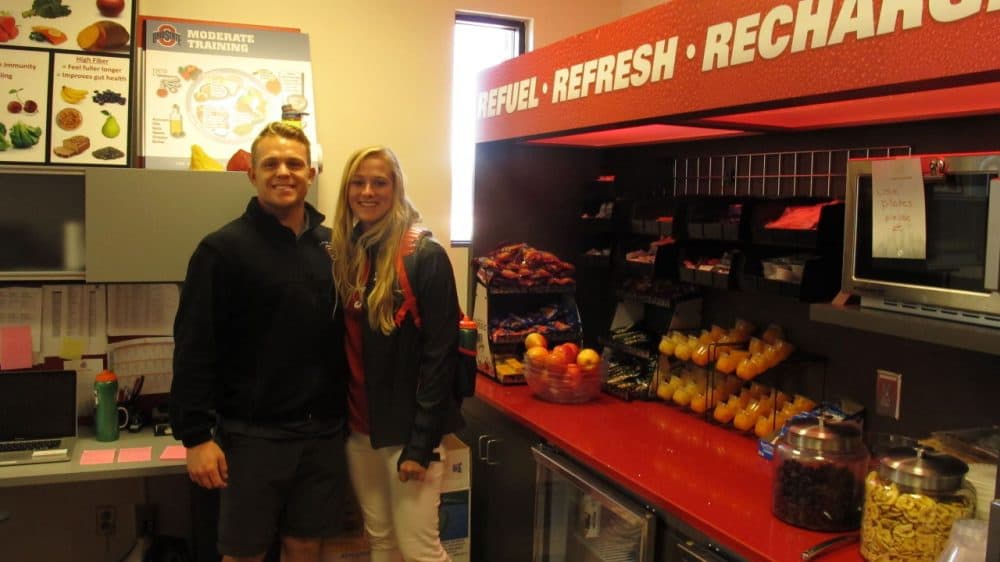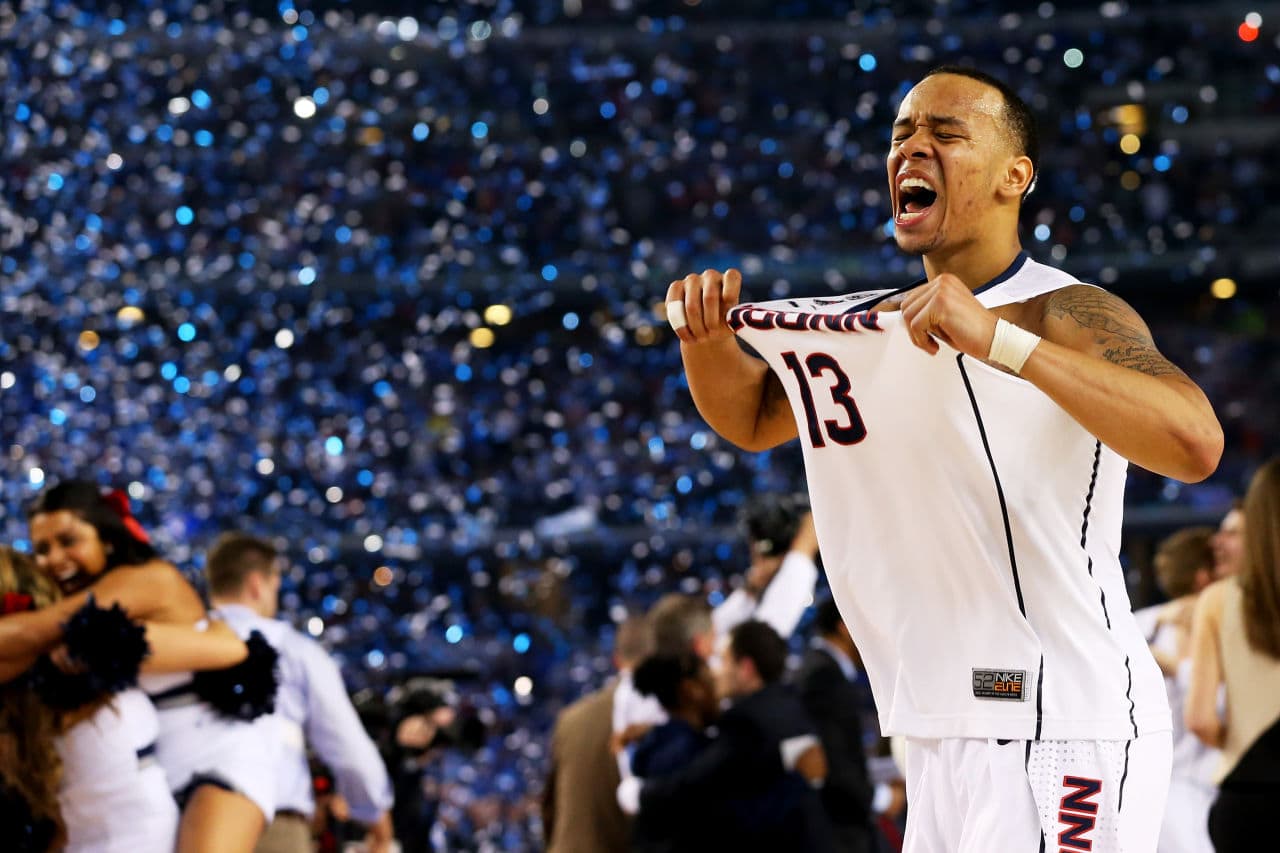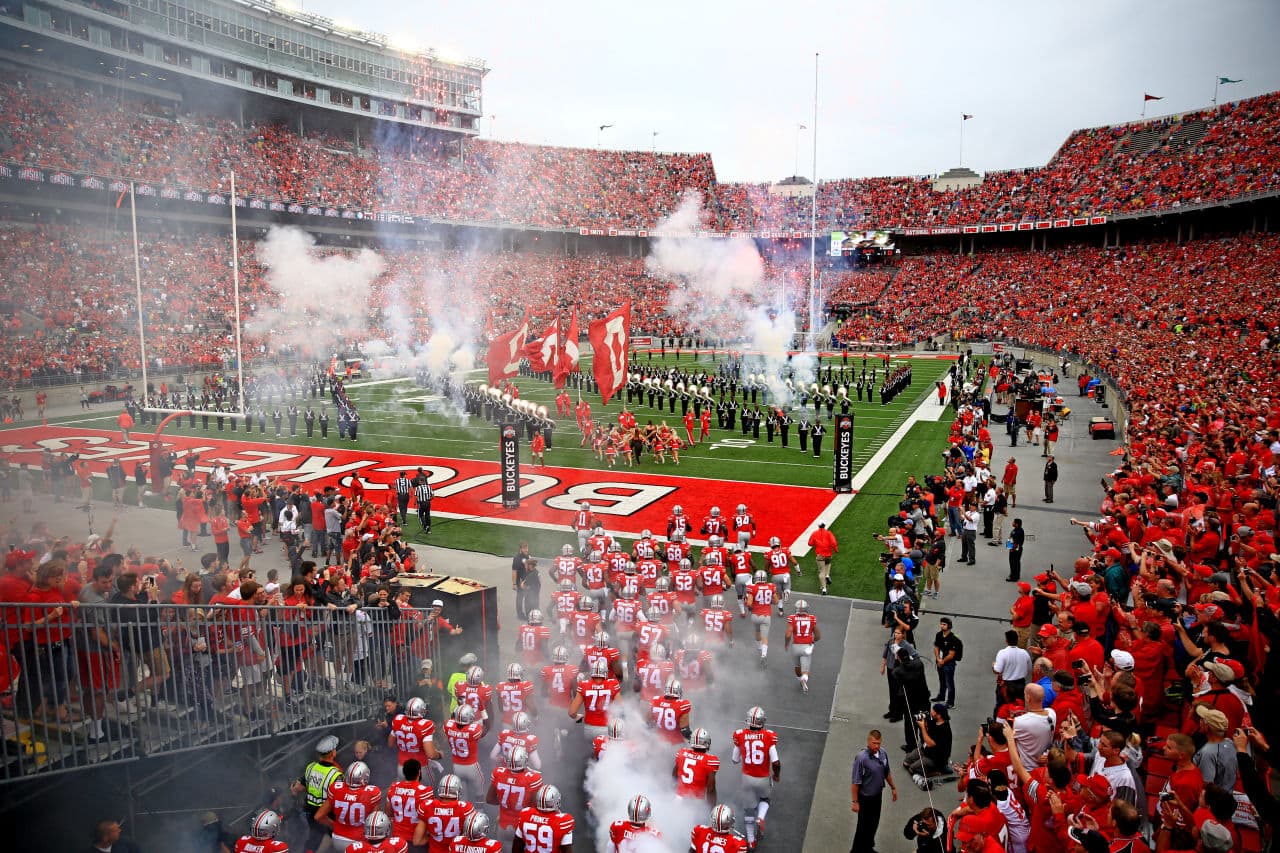Advertisement
Unlimited Snacks: Recruiting Tool, NCAA Gimmick, Or The Right Move?
Resume
"We have sushi. There's like naan roll-ups," says Ohio State softball player Maddy McIntyre as she shows me around a small room in one of the Buckeyes' athletic facilities. "And then we also have stuff for breakfast. So there's like ham and egg McMuffins, bagels, cereal."
It's a recent Monday afternoon in Columbus, and I'm there to check out one of the two new "fuel zones" on campus. Refrigerators are stocked with juices and yogurts. On a counter are jars full of banana chips and raisins.
Ohio State athletes can come here to fuel up before and after practices and games. And everything is free.
There are hungry nights that I go to bed and I’m starving.
Former UConn star Shabazz Napier in 2014
"My roommate and I were talking over the weekend," McIntyre says. "We were like, 'Oh, we need to go to the grocery store.' She's like, 'At least we don’t have to buy lunch meat.' We just grab a sandwich."
But just over a year ago, McIntyre and other Ohio State athletes did have to buy their own lunch meat — and their own egg sandwiches and their own sushi.
That’s because the NCAA — the governing body for college sports — used to regulate snacks. Colleges were allowed to provide athletes with only certain free foods, like bananas and nuts.
But then in March 2014, everything changed. That’s when former University of Connecticut basketball star Shabazz Napier led his Huskies through the NCAA tournament to the national championship. During that run, Napier told reporters something that made many fans uneasy: "There are hungry nights that I go to bed and I’m starving."
The sport’s biggest star complaining of hunger in the middle of a tournament generating hundreds of millions of dollars for the NCAA? The sound bite pinged across the Internet. Eight days later, the NCAA voted to lift the limits on snacks.

A New (Recruiting) Frontier
"That day I probably got 100 texts: 'Can you believe it? Finally!'" recalls Sarah Wick, a sports dietitian at Ohio state.
[Recruits] think it's awesome. They'll be looking in here, and they'll be like, 'Oh, can we have one?' And we're like, 'No... If you commit!'
Maddy McIntyre, Ohio State softball player
Wick and her colleagues had already been calling for deregulation.
"We saw that the athletes were coming in on empty," Wick says. "They were coming into a 6 a.m. workout and not have eaten since 8 o’clock the night before. You just can’t perform that way that you’re expected to perform as a collegiate athlete."
Since the rule change, total spending on feeding athletes at OSU has reportedly doubled to $1.5 million a year.
When current athletes like McIntyre or Ohio State coaches show recruits around campus, they make sure to bring them by the fuel zones.
"They think it’s awesome," McIntyre says. "They'll be looking in here, and they'll be like 'Oh can we have one?' And we're like, 'No… if you commit!'"
And that brings up an important point: recruiting. Historically colleges have competed for players by offering state-of-the-art practice facilities or fancier dorms.
Now there’s food. And Ohio State isn’t the only campus ramping up its offerings. According to a recent survey of big-time college programs, average spending on food for athletes has increased from about $500,000 a year to $1.3 million.
According to the New York Times, spending has outpaced what analysts and administrators predicted. But Victor Matheson, a sports economist at College of the Holy Cross in Massachusetts, isn’t surprised.
"They can’t compete for players based on how much they pay them, so the way you compete for all these best players is to add all of these amenities that aren’t technically salary but also add up to some nice goodies for the players," he says.

A Widening Gap
And now, free snacks are the new goodie – one available to athletes but not to other students. Even on a sports-mad campus like Ohio State, someone has to have a problem with that, right?
The more the athletes look like Oliver coming up with his little bowl and asking if, ‘Please sir can I have some more,’ the better they look in court saying, ‘I am being exploited by the NCAA.
Victor Matheson, Holy Cross sports economist
"Wow, yeah. That looks beautiful," Metzler says.
"For free? That's really nice," Gallagher says.
But Metzler and Gallagher are quick to point that athletes work hard — and some of them generate a lot of money for Ohio State.
Later, I ask Matheson from Holy Cross if he shares my sympathy for Metzler and Gallagher, who are stuck buying mushy apples from the library café.
"We have this artificial idea that these football players and basketball players at top institutions are really scholar-athletes," Matheson says. "No. What they are is they’re athletes who are generating huge amounts of money for the college, as opposed to pretty much everyone else is a real student who is going there to purchase education."
But more than a new recruiting tool for universities or an extra perk for athletes, Matheson sees the NCAA’s move to deregulate food as posturing during a period of legal uncertainty. The NCAA is currently being sued by former players who think college athletes should get a cut of the billions generated by TV deals, ticket sales and merchandise.
"The more the athletes look like Oliver coming up with his little bowl and asking if, 'Please sir can I have some more,' the better they look in court saying, 'I am being exploited by the NCAA,'" Matheson says.
But Wick doesn't see it that way.
"Nutrition and feeding the athlete is not a gimmick," she says. "I think they’re trying to keep the athletes as healthy as possible. And you gotta have that nutrition and that nutrition component."
And Wick may soon have even more resources to keep athletes well fed: Ohio State is already having meetings, she says, about building a full-on, centralized cafeteria for athletes.
In the meantime, athletes like Maddy McIntyre already have plenty of choices.
This segment aired on November 7, 2015.
